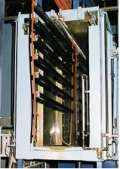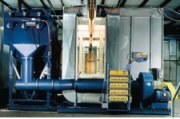Powder Coating at Paltier
New powder coating line handles big, big pieces...
You run into Lowe's hardware store. Grab a couple gallons of paint, rollers, brushes, maybe some electrical outlets, screws and a few two by fours. Did you pay any attention to the shelving holding these items? Probably not, but Lowe's does. And it insists that the finish be faultless. That is why it has its shelving manufactured and coated at Paltier, Inc. in Michigan City, Indiana.
Paltier recently converted from a liquid paint system to a powder coating system. "Ever since I started with the company in 1993," stated James Washington, vice president, "I was convinced we had to update our finishing system." The previous system was a monorail conveyor system. The paint was an electrostatically applied solvent-borne air-dry system. Paltier provided some warm air to speed drying, but it was not a cured finish.
Featured Content
The Clean Air Act Amendments and other regulations forced Paltier to give up its solvent-borne paint system. "Government edict," Mr. Washington stated, "took all the `good stuff' out of air-dry paints. We could not get the finish we used to, although the system was very efficient. We were running 32 fpm."
Most of Paltier's competitors had switched to state-of-the-art systems. There was no one particular system, however. Some converted to waterborne paints, others switched to high-solids and still others opted for electrocoating.
The company purchased a line that was large enough to handle its biggest pieces, 33 ft long, 33 inches wide and six feet high. The system was also capable of running 1,500 lb loads on 30-ft load bars, with the capacity for 4,000 lbs or more for many outsize pieces. At first, Paltier stored the line rather than install it immediately, because it was considering moving the company out of Indiana. However, once Paltier decided to remain in Indiana, it set to work installing the powder coating line.
One powder coating booth is from Eisenmann. The other booth, the J.O.B., was purchased new from The Finishing Group. The J.O.B. booth features closed-circuit air flow. The closed-circuit design creates a balance of air around the part as it is coated. It draws air out of the bottom of the booth and returns to the spray area 90 pct of the exhausted air, drawing in only enough outside air to create a negative pressure through the booth openings. This allows minimal air movement in the spray area and maximum transfer efficiency.
The J.O.B. booth system also features interchangeable recovery systems. Paltier uses about 16 powder coating colors from Morton International Powder Coatings. Powder can be recovered into a rollaway module for the recovery of 98 pct of one color. That module can be rolled away and in its place a cyclone can be connected to the same discharge outlet on the booth for recovery of 80 pct or more of multiple powder coating colors.
The ovens that came with the system had to be massively reconfigured. Previously, the line had been used for finishing the interior buckets of dishwashers and trash compactors. Paltier's products are much longer and have a different shape than the appliance pieces. Because of the products' length, the company installed a Jervis Webb Co. power-and-free conveyor system with several indexing stations.
After loading parts onto the conveyor, they are pretreated. "We started out running zinc phosphate, but it was far too complex for us. We needed a bath that was easy to control and could provide 1,200 hrs salt spray resistance. We chose DuBois Chemicals as a single-source supplier because the company took care of everything, including waste treatment. Single source is important because we are early in the learning curve," explained Mr. Washington.
The pretreatment sequence runs as follows: wash, rinse, rinse, phosphate, rinse, seal and DI mist rinse. The iron phosphate is IPI-25NF, which is designed for multi-metal prepaint processing; however, Paltier only processes steel through the system. Temperature in the iron phosphate stage is 140F. Dwell time is one to one-and-a-half minutes. Phosphate conversion coatings require 30 seconds to form. It provides 25 to 40 mg/sq ft typically under normal operating conditions. The pH is maintained at 4.0.
The non-chrome final seal is ICA-503. It is a rinse additive for use after iron phosphating. ICA-503 provides a sealing action over iron phosphate that improves paint adhesion and extends corrosion resistance. The sealer is used at very low concentrations and a pH between 5 and 6.
Following the washer, parts move through a dryoff area and then through one of two powder coating booths. The Eisenmann powder coating booth is used for applying only two of the 16 colors since there are only two sets of recovery cartridges. "That booth is used mostly for our orange powder coating jobs," noted Mr. Washington, "since the orange color is pretty ubiquitous and needs to be carefully controlled." The J.O.B. booth is used for the other colors. Reciprocating guns are used to apply the powder.
"My ultimate goal is an average of 1.6 mils of powder coating on the parts. Never less than one mil and never more than two mils. We have not achieved that yet," noted Mr. Washington. This is not easy to achieve when you are running 16 colors. Some colors, such as yellow, run thicker than others. "We achieve good coverage at lower thicknesses with the gray powder coating, which we spray most often," noted Mr. Washington.
Parts cure in a 425F convection oven for 14 minutes. Using a Datapaq system, part temperature was determined to be 350F at this oven temperature. Part thicknesses range from one-quarter-inch to three-eighths-inch thick steel. The heaviest pieces are structural steel uprights that weigh in at 18 lbs/ft.
After curing, parts cool down and are unloaded, packaged and shipped. "This project has been much more complex than I thought it would be. There are a lot of things I expect to do and hope to do down the road. We are looking for contract finishing work in large pieces. There are many custom coaters, but not many that can handle pieces 25 to 30 ft long. We want big pieces no one else can handle," remarked Mr. Washington.
RELATED CONTENT
-
Touch-up Options for Powder Coated Parts
Is it true that powder coating cannot be touched up? Powder coating expert Rodger Talbert offers options for powder coating touch-ups.
-
Preparation of Stainless Steel for Powder Coating
Should type 316 stainless steel castings be sandblasted before powder coating, or can they be chemically etched? Should the parts be pre-heated in an oven before coating?
-
Anodizing Vs. Powder Coat
I am an engineer on a large yacht build project and urgently need information and advice on choosing a finish for the aluminum deck plates in the engine room.





















